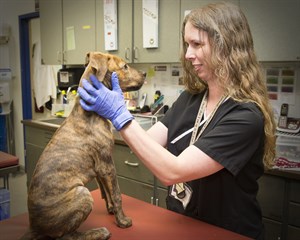Veterinary Technicians Help Pets Stay Healthy
As pets become more of an integral part of the family, the demand for skilled veterinary technicians continues to rise. Veterinary technicians play an integral role in your pet’s health. If you’re a self-motivated, personable individual who likes working with animals and people, you may want to consider a career as a veterinary technician.

“A veterinary technician is the equivalent of a nurse in the human health field, only they work with animals,” says Mary Sanders, a registered veterinary technician in the College of Veterinary Medicine and Biomedical Sciences at Texas A&M University. “Veterinary technicians typically assist the veterinarian with exams, administering medications, bandaging, laboratory work and assisting in surgery and post op recovery,” Sanders says. ” In some private veterinary practices, the technician may also be running the front desk and cleaning out the cages in the back.”
In addition to working in private clinics and animal hospitals, veterinary technicians also may work in research facilities, pharmaceutical sales, federal and state government agencies, wildlife medicine, zoos, livestock management, boarding kennels, animal shelters, stables, grooming shops and more.
“Persons interested in a veterinary technician career should have a solid background in math and science, be personable, and possess good communication skills,” says Sanders.
“Because technicians at times deal with pet owners who are under duress, it is helpful to know how to explain what is happening to their pet in a compassionate manner. Other beneficial qualities would include the ability to think on your feet and good organizational skills.”
The American Veterinary Medical Association (AVMA) accredits veterinary technician programs throughout the United States, notes Sanders. Most AVMA-accredited programs lead to an associate’s degree after two years, but some lead to a four-year baccalaureate degree.
“Graduation from an AVMA-accredited veterinary technology program allows students to take the credentialing exam in Texas as well as many other states in the country,” explains Sanders. “Candidates are tested for competency through an examination which includes oral, written, and practical portions.
To maintain their certification status in Texas, technicians are required to have a certain number of Continuing Education Units (CEU) each year.
Pet owners today are more willing to pay for advanced care because pets are considered a family member in many households, spurring employment growth for skilled veterinary technicians. “In the old days, your family was no more than two miles away from you in any direction. Now, you may not even see your parents once a year or longer because of the distance that people live apart,” Sanders says. “We live in such a transitional society and people need the comfort of coming home to something. In many cases that is a pet. Also, people are staying single longer and they want the companionship.”
Veterinary technicians earn salaries that compare favorably to those in other fields requiring a similar education. Salaries vary according to experience, responsibility, geographic location, and employment type. In May 2008, median yearly earnings of veterinary technicians were $28,800.
Veterinary technology offers a fast growing and challenging career for mature and motivated individuals. Sanders says that if you are a self-starter who likes to work with people and animals, a career as a veterinary technician may be the perfect career choice.
The Texas A&M College of Veterinary Medicine & Biomedical Sciences has partnered up with Blinn College, in Bryan Texas, to offer a Vet-Tech program. The first set of classes is scheduled to start in the fall of 2010. For more information on this unique program, contact (979) 209-7203.
ABOUT PET TALK
Pet Talk is a service of the College of Veterinary Medicine & Biomedical Sciences, Texas A&M University. Stories can be viewed on the Web at vetmed.tamu.edu/news/pet-talk. Suggestions for future topics may be directed to editor@cvm.tamu.edu.


